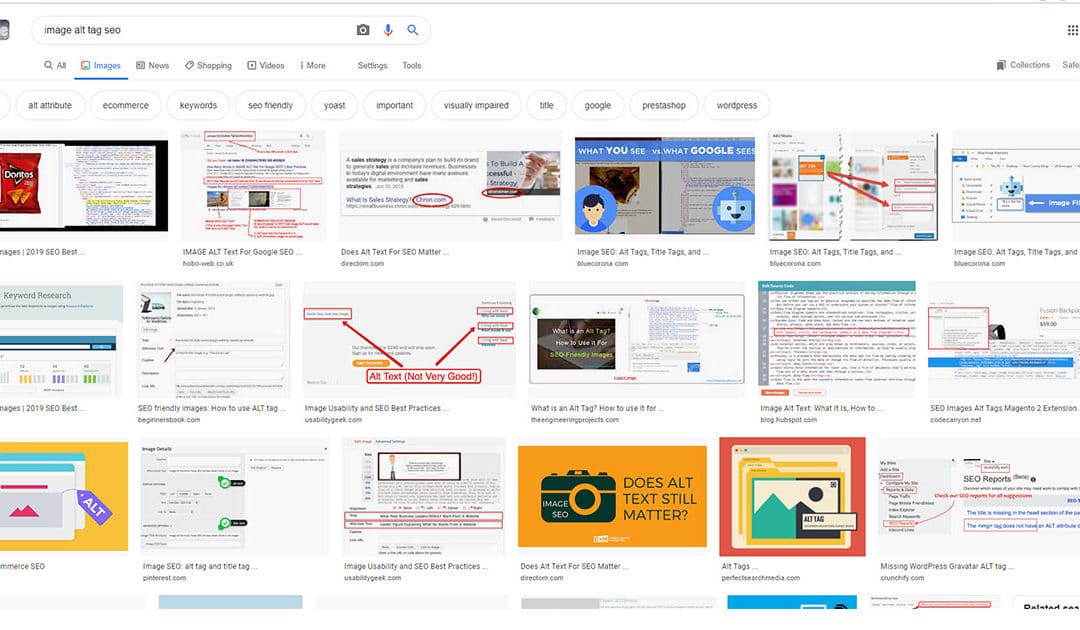ALT text is text you can add to your HTML code to describe an image textually. You may hear them referred to as “alt Tags” (technically incorrect as they’re not tags), “alt descriptions”, or “alt attributes”.
Three Great Reasons to Use ALT Text
- Enhanced Accessibility: In Canada, it is law for organizations with more than 50 employees to have a website that is Website Content Accessibility Guidelines (WCAG) 2.0 compliant. WCAG is a topic for another day. Alt text allows site visitors who use screen readers to get an understanding of what your images are about.
- Reinforce Your Page Keywords: Your webpage has a topic. If you include images on the page you can use the alt text in a way that reflects the content of your page. Your image is relevant, so the image’s alt text should be as well.
- Be Found in Google Image Results: The above image is a screen capture of the results of a Google image search for “image alt tag seo”. Lots of searches are done for images. Unfortunately, search engines have no way of deciphering what an image is about unless there is alt text that goes with it. If you don’t have alt text, your image won’t be displayed in image search results.
How to Use Image Alt Text
There are good and bad ways to use alt text. Let’s look at a few examples with this photo.
 <alt=””> – This has no alt text. Bad.
<alt=””> – This has no alt text. Bad.
<alt=”car”> – True at the most base level.
<alt=”red car”> – True, but not very specific.
<alt =”red sports car”> – Getting better, but could be more specific.
<alt=”Red Ferrari”> – Better, but it could be more precise.
<alt=”Red Ferrari F8 Tributo”> – Even better, but there could be more detail.
<alt =”Red 2019 Ferrari F8 Tributo on static display at Geneva automotive show”> – Much better.
Why is the last one the best of the bunch? It’s the most specific and descriptive. Even if the image didn’t display (which happens sometimes), reading the alt text would give you a pretty clear idea what the missing image is displaying.
Alt Text Abuse
Just because search engines index alt text doesn’t mean you should abuse it. Here’s another example based on the above image.
<alt=”Red 2019 Ferrari F8 Tributo Geneva Switzerland Lamborghini Porsche Audi BMW Mercedes Luxury Sports Performance Car Automobile”>
The above is an example of stuffing keywords into alt text and providing a description of vehicles that aren’t in the image at all. Highly not recommended. Google’s algorithm can figure out whether your alt text is likely to be relevant based on the rest of the content on your page. Be descriptive and specific and you’ll be more likely to be treated well by Google.
I hope you’ve enjoyed today’s article on alt text. Please leave a comment below and let us know what you think! Tune in for tomorrow’s on page SEO tip!


Image Alt tag or text are really very important for Image reading by Google bots. Alt text is doing a very vital role in Search engine optimization. I always use to mention the information of image and targeted keyword in the alt tag. Alt tag or text are really very important for Image reading by Google bots. Thanks for sharing this information which is very useful and most of people just missed it, but you helped a lot. Subscribed your blog.
This post provides a clear and concise explanation of what alt text is and how to optimize it for on-page SEO. Beginners in the field should know about it.